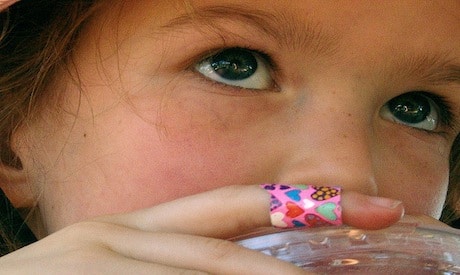
A travel-sized colloidal silver bottle can fit in your handbag, purse or luggage. It’s a versatile, handy little first-aid tool that can benefit you in many circumstances–even replacing antibiotic use in some some situations.
It is wise to use natural substances with respect because they have great power, and if we appropriate just the right amount, they can benefit us incredibly well. Think of the miraculous way that molecules of plants and minerals convert into parts of our bodies after we ingest them. And then think of how eating too much of one kind of food adversely affect us, even if that food is good. For example, eating too many carrots can eventually turn your skin yellow! Similarly, ingesting or applying too much colloidal silver can make your skin turn blue–a condition known as argyria. It would take a lot of carrots or silver to change most people’s skin color, though, so if we consume these substances with caution it should be an easy matter to keep our skin tone normal.
To help us, the Silver Safety Council has given us guidelines for safe silver use and a means of calculating safe silver intake daily and during a lifetime. Their website also provides links to US Government sites on silver safety.
Here are some of the conditions that benefit from colloidal silver use:
- Ear infection
- Eye infection
- Sinus infection
- Gastro-intestinal infections
- Corns and warts
- Cuts and wound dressings
Read more about colloidal silver and other natural antibiotic alternatives
History of colloidal silver use
Anti-microbial use of silver extends back to ancient times when peoples in the Mediterranean region used silver to help control infections and prevent food from spoiling. Hippocrates noted around 400 AD the benefits of silver for controlling ulcers. From 702 AD to 980 AD Middle Easterners used it to treat bad breath, heart conditions and purify the blood.
During the Napoleonic Wars and First and Second World Wars, soldiers carried water in silver drinking vessels because it kept the water clean. Before modern antibiotics were discovered in the 1940s, colloidal silver was used as an antibiotic in hospitals. And nowadays, hospitals still enjoy the benefits of silver in the form of its application to catheter coatings, which prevents bacteria from traveling up these pathways and into the body. Anecdotal evidence of long-term silver usage plus recent studies confirm silver’s antibiotic properties make a compelling case for giving its benefits a try. See if it will work for you!
Read more about antibiotic ineffectiveness
Photo credit: silydog




